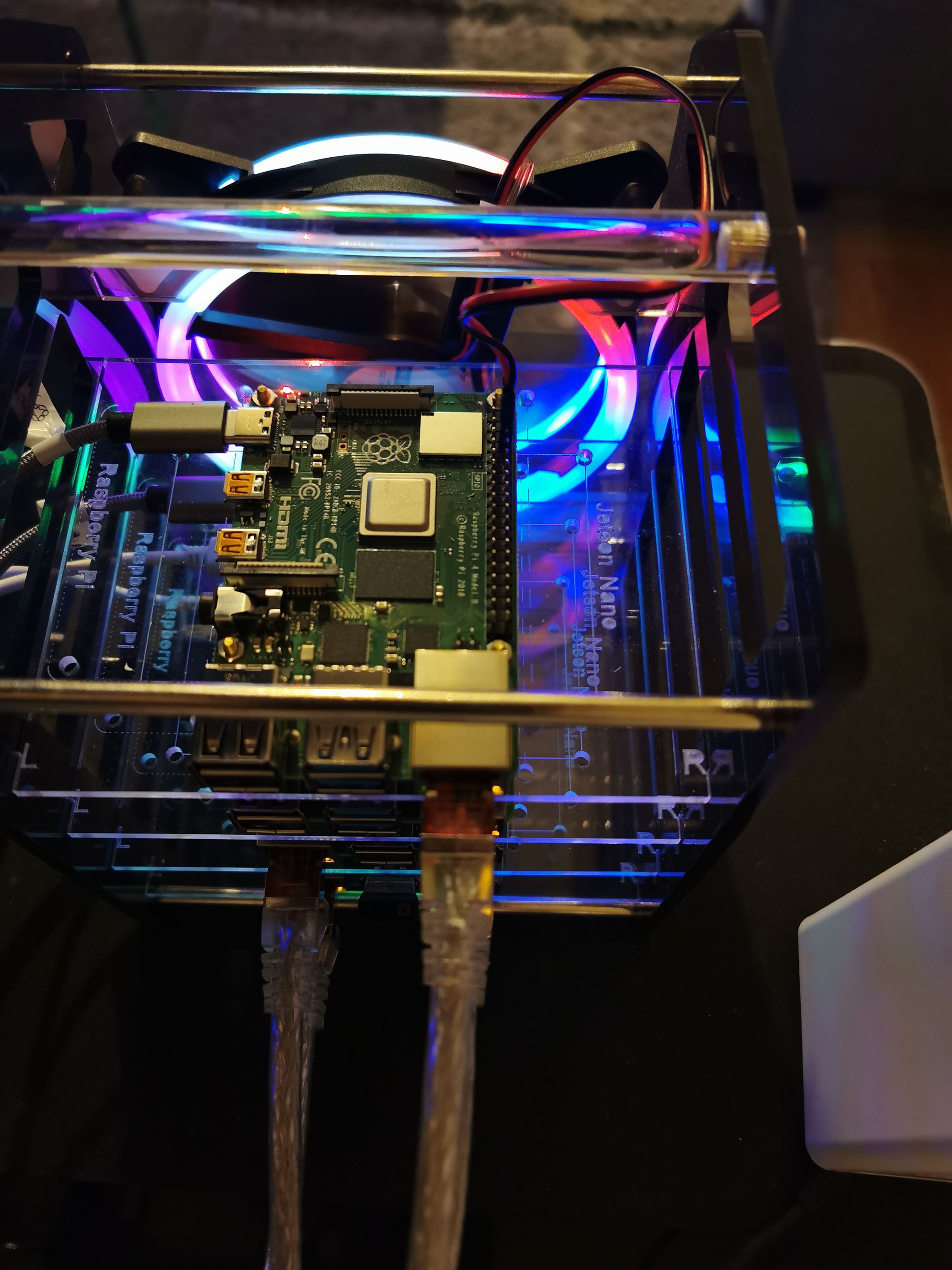By this memo, i purpose you to discover how deploy a Kubernetes K8S solution on your own cluster composed by some raspberry.
Preparing nodes
We need Raspbian Release with ability to support Docker, so we will use HypriotOS available here.
curl -OJSLs https://github.com/hypriot/image-builder-rpi/releases/download/v1.12.0/hypriotos-rpi-v1.12.0.img.zip
unzip hypriotos-rpi-v1.12.0.img.zipNow we need utility for Flashing SD Card with forcing some instance parameters, like user, hostname, ... Hypriotos Flash Tool will be most efficience and available here.
curl -LO https://github.com/hypriot/flash/releases/download/2.5.0/flash
chmod +x flash && sudo mv flash /usr/local/bin/flashFlashing now, i have one master node and four worker nodes
flash --hostname master hypriotos-rpi-v1.12.0.img
flash --hostname north hypriotos-rpi-v1.12.0.img
flash --hostname south hypriotos-rpi-v1.12.0.img
flash --hostname east hypriotos-rpi-v1.12.0.img
flash --hostname west hypriotos-rpi-v1.12.0.imgConfiguring
I - Inventary
To configure our cluster, we will use some Ansible playbook, it's more powerful and can be reused with new nodes if we want.
We start by dowloading Ansible playbook available here.
Then, wi start by adjusing host configuration ; setting of master and worker IP, next setting of ssh user and password (for me i use same credentials for all nodes for simplicity)
sed "s/{{masterip}}/[MASTERIP]/" hosts.dist > hosts
sed -i "s/{{northip}}/[NORTHIP]/" hosts
sed -i "s/{{southip}}/[SOUTHIP]/" hosts
sed -i "s/{{eastip}}/[eastip]/" hosts
sed -i "s/{{westip}}/[westip]/" hosts
sed "s/{{user}}/[USER]/" group_vars/all.yml.dist > group_vars/all.yml
sed -i "s/{{password}}/[PASS]/" group_vars/all.ymlII- Preparing OS
Executing "bootstrap", will configure all raspberry with enabling cgroup for memory , cpu and disabling all swap.
ansible-playbook bootstrap.yml -i hosts --verboseNext step, installing all common dependencies for Kubernetes on master node before initializing cluster with KubeAdmin.
ansible-playbook master.yml -i hosts --verboseFinally, install dependencies on worker nodes and join master node.
ansible-playbook node.yml -i hosts --verboseSet Up Cluster
I- CNI
Kubernetes need a network plugin to manage cluster intra-communication. For our project, i choose to use Flannel with some adjucing (like ARM image arch).
kubectl create -f kube/flannel.yml
kubectl create -f kube/kubedns.yml
# Must be done on all node
sudo sysctl net.bridge.bridge-nf-call-iptables=1II- Ingress
Ingress manages external access to the services in a cluster, may provide load balancing, SSL termination and name-based virtual hosting. For ower project we use Nginx Ingress.
helm repo add stable https://kubernetes-charts.storage.googleapis.com/
helm install nginx-ingress stable/nginx-ingress --set defaultBackend.image.repository=docker.io/medinvention/ingress-default-backend,controller.image.repository=quay.io/kubernetes-ingress-controller/nginx-ingress-controller-arm,defaultBackend.image.tag=latest,controller.image.tag=0.27.1
helm install ingress stable/nginx-ingress --set controller.hostNetwork=true,controller.kind=DaemonSetFor Cluster public IP
# Check public IP if set
kubectl get svc ingress-nginx-ingress-controller -o jsonpath="{.status.loadBalancer.ingress[0].ip}"
# You can set it manual
kubectl patch svc nginx-ingress-controller -p '{"spec": {"type": "LoadBalancer", "externalIPs":["[YOUR-PUBLIC-IP]"]}}'
Trooblshooting
If Pod cannot communicate, or if CoreDNS canno't be ready, run in all node
sudo systemctl stop docker
sudo iptables -t nat -F
sudo iptables -P FORWARD ACCEPT
sudo ip link del docker0
sudo ip link del flannel.1
sudo systemctl start dockerIII- Storage
For Storage solution, we can deploy a CEPH server or NFS service and configure cluster to use it. For our project, we will install NFS server on master node
sudo apt-get install nfs-kernel-server nfs-common
sudo systemctl enable nfs-kernel-server
sudo systemctl start nfs-kernel-server
sudo cat >> /etc/exports <<EOF
/data/kubernetes-storage/ north(rw,sync,no_subtree_check,no_root_squash)
/data/kubernetes-storage/ south(rw,sync,no_subtree_check,no_root_squash)
/data/kubernetes-storage/ east(rw,sync,no_subtree_check,no_root_squash)
/data/kubernetes-storage/ west(rw,sync,no_subtree_check,no_root_squash)
EOF
sudo exportfs -a On worker node
sudo apt-get install nfs-commonNext, we deploy NFS service
kubectl apply -f storage/nfs-deployment.ymlIt's will create new storage class and marked it to default then deploy storage pod.
Now to test configuration
kubectl apply -f storage/nfs-testing.ymlTricks
I- Cluster backup
To backup our cluster, we need to run
./os/backup.sh # cluset data will be saved in ~/bkpII- Cluster tear down
To reset cluster, just run on master node
kubeadm resetIt's Ready
After a little time, all nodes must be ready
kubectl get nodes -o wide
NAME STATUS ROLES AGE VERSION INTERNAL-IP EXTERNAL-IP OS-IMAGE KERNEL-VERSION CONTAINER-RUNTIME
east Ready <none> 23h v1.17.4 192.168.1.30 <none> Raspbian GNU/Linux 10 (buster) 4.19.75-v7l+ docker://19.3.5
master Ready master 63d v1.17.1 192.168.1.17 <none> Raspbian GNU/Linux 10 (buster) 4.19.75-v7+ docker://19.3.5
north Ready <none> 63d v1.17.1 192.168.1.54 <none> Raspbian GNU/Linux 10 (buster) 4.19.75-v7+ docker://19.3.5
south Ready <none> 63d v1.17.1 192.168.1.11 <none> Raspbian GNU/Linux 10 (buster) 4.19.75-v7+ docker://19.3.5
west Ready <none> 23h v1.17.4 192.168.1.85 <none> Raspbian GNU/Linux 10 (buster) 4.19.75-v7l+ docker://19.3.5Enjoy ...

